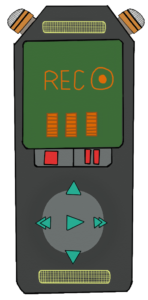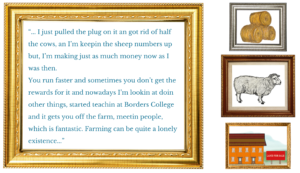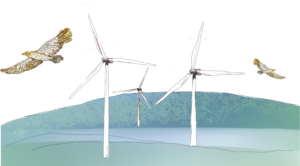Written by: Rebekah Day, RESP Curatorial Intern
From December 2023 to May 2024, I have had the pleasure of working on curating an online exhibition for the Regional Ethnology of Scotland Project (RESP).
View the exhibition: www.exhibitions.ed.ac.uk/exhibitions/animal-encounters
After successfully interviewing for the Regional Ethnology of Scotland (RESP) curatorial internship, I was given information from the Project team on a whole range of topics and themes that could be used as a basis for the exhibition but was assured that I had the choice to pitch my own idea. After some back and forth discussions about what kind of content and topics I was likely to find in the RESP interviews, I started to listen to some of the recordings available on the website and found myself drawn to the stories people shared that included interactions with animals.
I pitched the idea of my theme being ‘Animal Encounters’ giving the following rationale:
It can be said that the RESP archive, and ethnology more widely, is concerned with studying and recording the everyday stories of people – but ostensibly they also capture the nuances of the universally shared, yet deeply individual, human experience.
A surprising theme that reoccurs throughout the interviews is the significance of animals, which appear in a huge variety of the memories and stories individuals have shared with the RESP archive.
The rural locations where many interviews have been carried out naturally mean that individuals have shared connections to agricultural activity such as farming, so it is no surprise that stories of animals framed by this industry occur – what is interesting though, is just how many spheres of influence animals crop up in throughout a person’s life.
Some of these stories recount the chores involved raising farm animals, the joy of playing with a beloved family pet, the intensive labour involved in abattoir work, the impact of poaching and cattle theft on communities, or lamenting the loss of fields used for grazing now given over to modern housing estates.
By selecting the specific subject of ‘animals’, this exhibition will provide a window into the RESP archives – encouraging audiences to delve more deeply into the RESP website and other CRC collections for their own research.
This exhibition will also provide a timely and entertaining resource for students and those interested in local history, encouraging discussion about the changing relationship between Scotland’s people and the natural environment.
Given the go ahead, I was then trained in how to use the exhibitions website so I could see what kind of content could be displayed and what layout was possible. I was also guided on what external organisations and volunteers associated with RESP I could approach to ask for visual content such as photographs and videos.
Caroline Milligan also provided me with an extensive list of interviews
that she knew mentioned animals – you can see the whole list here. When first listening to these, I wanted to stop and write down the time stamp for every little anecdote I thought was interesting, but this would have taken forever!

Instead I listened to a couple of them the whole-way through the first time around with my digital drawing tablet set up. I soon found that just doodling away while listening to the interviews clarified that the topics and themes I was clearly drawn to involved animals and nature.
Going back to make notes of relevant stories from some of these interviews and thinking about the kind of illustrations I was producing, and the other visual content RESP had access to, I was able to suggest three ‘categories’ that the content could be placed in, to provide a framework for the exhibition.
The three categories ‘for us,’ ‘with us’, ‘around us,’ are not intended as concrete descriptions, but as loose themes that can frame or challenge your interpretation of the kind of interactions between people and animals that can be found in the exhibition.
I found reference images on the internet to ensure I was getting things like the colours, details and proportions somewhat right for these illustrations. Some interviews discussed populations of pheasants, kites and lapwings which I guessed were birds, but only thanks to a Google search could I confidently replicate what they looked like!
This exercise in itself was eye opening – searching out further details from the fleeting comments made within an interview gave me such a greater appreciation for the topics people were discussing.
For example, discovering that lapwings, also known as ‘peewits’, had adorable pointy head-feathers and nested on the ground, helped me imagine how these creatures would have stood out to a person gazing across the landscape.
I could imagine the parent birds watching over their cute fluffy chicks, but also worrying as farm machinery and road traffic milled by dangerously close to their nests.
I was really inspired by how a previous intern for the Friends Exhibition used their own illustrations throughout the exhibition; her scrapbook-style collages neatly frame the pages and provide a visual connection between collection items that might have otherwise felt disparate. The illustrations in the Friends Exhibition enhance the viewers experience while navigating the website, but do not draw any focus away from the key material on display. This was a method I hoped to replicate by including my own drawings in the Animal Encounters exhibition.
To give the idea that my illustrations were visual components of a larger, multi-media, exhibition, I placed the individual illustrations in a variety of mismatching frames. This created a kind of jigsaw or collage to use on the homepage and in marketing material.

For each sub-page, I then took a smaller group of framed illustrations that felt relevant to the interviews and used these as header images.

Where I included audio clips from the interviews I tried to accompany these with images of the individual speaking or photographs from the location the interviewee came from. Where I could not find a relevant image, I instead took a quote from the interview transcription and placed it in a frame alongside some relevant illustrations.
photographs from the location the interviewee came from. Where I could not find a relevant image, I instead took a quote from the interview transcription and placed it in a frame alongside some relevant illustrations.
I felt this helped keep the content engaging and created continuity between different sections.
In the Friends Exhibition, the intern included a short recording of the Curator speaking about an item in the collection which inspired me to include a piece of my own connection to the themes explored in the Animal Encounters exhibition through a short interview with the RESP Project Archivist Lesley Bryson.
I had been eager to include mention of a connection we had discovered over the months since I started this internship. Through chatting about family history we realised that the area of Morningside where Lesley lives today is right by the location of the historic dairy my husband’s great-great-grandparents had lived and worked in the early 1900s.
I was recently sent some of these family photos and showed Lesley, who enjoyed seeing how different the street had looked in the past. She also told me that recent building works at her house had uncovered cow bones, possibly evidence of the historic dairy.
This interaction is the last story included in the exhibition as I feel that it surmises for me just how pervasive the connections between humans and animals remain across the decades.


